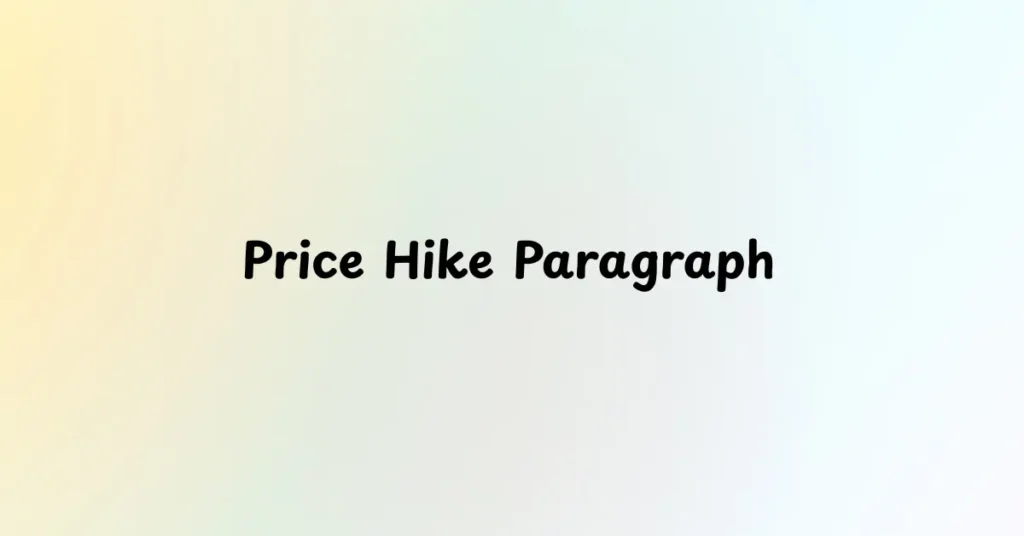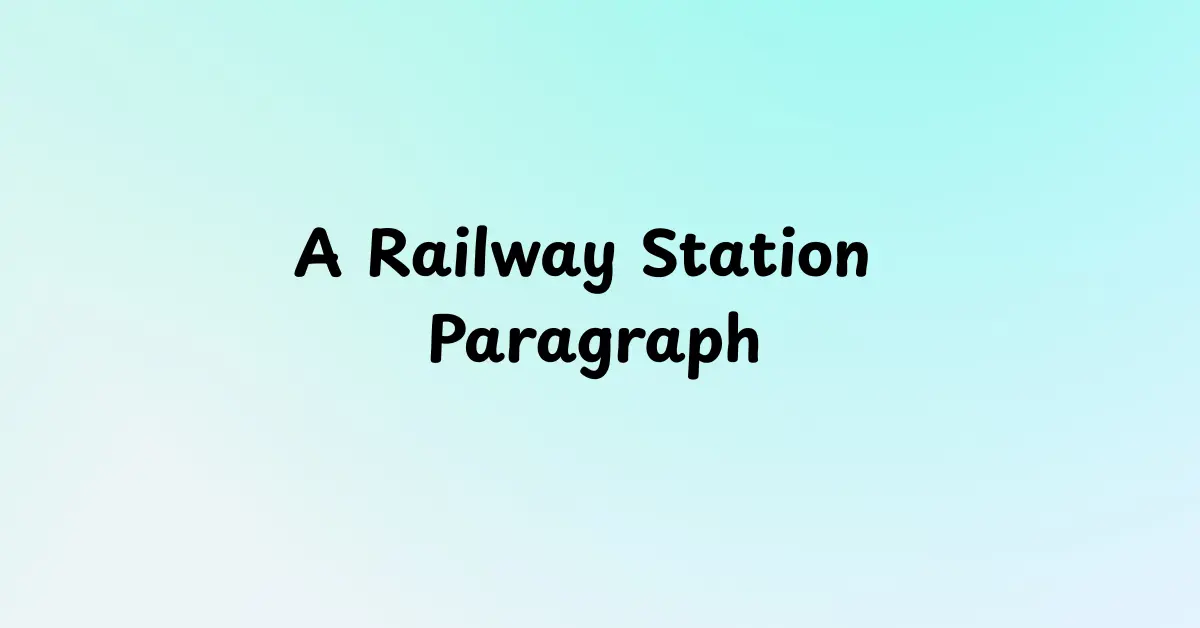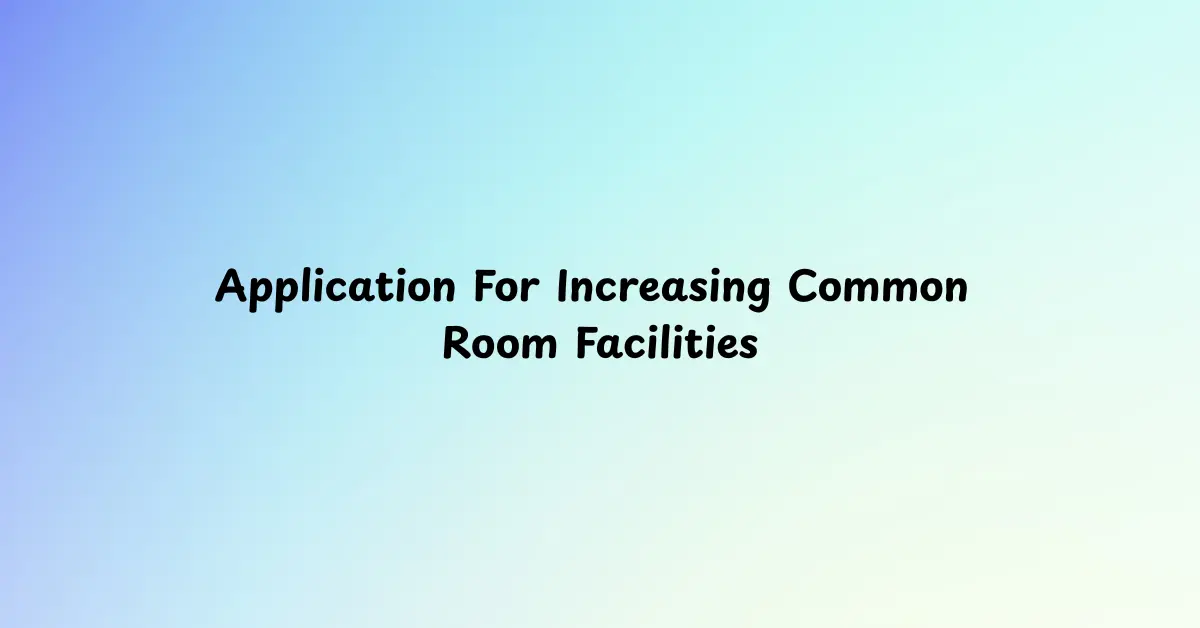A price hike means the cost of things like food, clothes, or fuel goes up, making it harder for people to afford daily needs. This Price Hike Paragraph explains why prices increase, how it affects families, and ways to manage it. Let’s start today’s lesson!
Q. Write a Paragraph on Price Hike
Price Hike Paragraph For HSC 300 Words
Price hike means the increase in the cost of things we buy every day, like food, clothes, fuel, and other items. It is a big problem for many people because it makes life harder. When prices go up, people have to spend more money to buy the same things they used to get for less. This can be very difficult, especially for families who don’t earn a lot of money. They may have to cut down on buying important things like healthy food or school supplies.
One reason for a price hike is when there is less supply of goods but more people want to buy them. For example, if there is less rice in the market but many people need it, the price of rice will go up. Another reason is the increase in the cost of making or transporting goods. If fuel prices go up, it costs more to transport goods, and this makes everything more expensive. Natural disasters like floods or droughts can also cause a price hike because they destroy crops and reduce the supply of food.
A price hike affects everyone, but it is especially hard for poor people. They struggle to buy even basic things like food and medicine. It can also make people save less money because they have to spend more on daily needs. To deal with this problem, the government can take steps like controlling prices and helping farmers grow more food. People can also try to save money by buying only what they need and avoiding waste.
Price hike is a serious issue, and everyone needs to work together to solve it. By being careful and helping each other, we can make life easier for everyone.
Price Hike Paragraph For SSC 250 Words
A price hike means an increase in the cost of goods or services. This can happen for various reasons. Sometimes it is due to rising costs of materials or transportation. Other times, it happens because demand for a product is higher than the supply. Price hikes can make it harder for people to afford everyday items like food, fuel, and rent. This can put extra pressure on family budgets, especially for those with limited incomes.
Businesses are also affected when prices go up. They may have to pay more for supplies or production. To cover these costs, they might raise their prices too. However, this can lead to fewer customers buying their products. It creates challenges for both sellers and buyers.
Price hikes are especially difficult when they happen suddenly. People may not have time to adjust their finances. This can lead to frustration and stress. Governments and organizations often try to help by finding ways to control price increases. For example, they might lower taxes or add more supplies to the market.
Solving the problem of price hikes is not always easy. It requires careful planning and teamwork. Communities, businesses, and policymakers must work together to find solutions. The goal is to make sure that goods and services remain affordable for everyone, while still supporting a growing economy.
Price Hike Paragraph 200 Words For Class 9 10
A price hike refers to an increase in the cost of goods or services. It impacts everyone, whether a family is picking up groceries or a company is managing costs. When prices go up, we often have to spend more money to purchase the same things we used to get for cheap. It can be challenging to save money or keep to a budget. Many factors cause a price hike. Take this one: for example, if raw materials all of a sudden cost more, companies can choose to pass this on to their products. Natural disasters or supply deficiencies can sometimes drive up prices, too. Inflation is another common reason; when the value of money decreases, the value of currency decreases as well. The increases can be particularly hard on people with fixed incomes; their earnings remain fixed, but their spending goes up. Few people will look for cheaper alternatives, buy less or, at least, try to cut back on nonessential items to manage a price hike. During such periods, it is important to keep up with changing prices and plan your expenditures.
Price Hike Paragraph 150 Words For Class 6 7 8
A price hike means an increase in the price of goods or services. This could happen for several reasons, including rising production costs, rising demand, or a reduced supply. A prime example would be that if a company uses more money to manufacture a product, it will sell the product at a higher price to balance those expenses. Consequently, businesses will raise prices if they know more people want to buy the product. Also, price hikes can be caused by external factors like a new tax or changes in conditions globally. It means they make it more and more difficult to do the everyday essentials of life, like food or fuel or other necessities that people have to afford. Small price increases can be overwhelming to families with tight budgets. If prices rise too quickly or stay too high for too long, it can cause economic problems. This is called inflation. However, solutions take time, and governments and organizations will often step in to control inflation and stabilize prices. Price hikes give us another reason to plan carefully how we spend and find ways to save wherever we can.
Price Hike Paragraph 100 Words For Class 5
A price hike is an increase in the price of goods or services. It occurs when you charge more than you previously were. There are many reasons for this. For example, things such as higher production costs, greater demand or issues with supply. The price hike impacts everyone but the low-income people the most. They may be unable to afford basic necessities such as food or fuel. Customers who used to buy expensive goods can stop buying them. There are price hikes around every corner, and sometimes they feel unjustified. But, they occur due to circumstances that are beyond our control. These price hikes don’t happen in a vacuum, which means understanding why prices rise can help you better plan and manage your money.
Price Hike Paragraph With Bangla Meaning
A price hike refers to increasing prices of goods or services. When the prices we pay for food, fuel, or clothing rise. That often makes life harder for many, whether they don’t earn much money. For many reasons, you can tuck in a price hike. Sometimes, that is because supply is limited. The farmers lose crops because of bad weather and vegetables and fruits become expensive. And there are other times it happens when production costs rise. Usually, the more businesses have to pay for the raw materials or for labour, the more the raw materials and labour costs will be charged to customers. Events that influence global affairs, including wars, natural disasters, and pandemics, can result in changes in prices. If prices go up, people need to spend more for the exact same things they used to buy. It also means they should cut down on savings or reduce their spending in other areas. In most cases, it results in less than business as it is quite difficult for many to afford high prices. To control the price hikes, governments may set limits or offer some subsidies. These are not always successful, though. If we know the reason behind the rise in price, we can plan better and spend our money through wise management.
অনুবাদ :
মূল্য বৃদ্ধি মানে পণ্য বা পরিষেবার দামের ঊর্ধ্বগতি। এটি ঘটে যখন আমাদের দৈনন্দিন ব্যবহারের জিনিস যেমন খাবার, জ্বালানি বা পোশাকের খরচ বেড়ে যায়। এটি অনেক মানুষের জন্য, বিশেষ করে যারা কম আয় করেন, তাদের জীবনে আরও কঠিন পরিস্থিতি তৈরি করতে পারে। মূল্য বৃদ্ধি অনেক কারণে হতে পারে। কখনও কখনও এটি সরবরাহের ঘাটতির কারণে ঘটে। উদাহরণস্বরূপ, খারাপ আবহাওয়ার কারণে কৃষকরা ফসল হারালে, ফল এবং শাকসবজির দাম বেড়ে যেতে পারে। আবার, উৎপাদন খরচ বেড়ে গেলে এটি ঘটে। যদি ব্যবসাগুলো কাঁচামাল বা শ্রমের জন্য বেশি খরচ করে, তারা সাধারণত গ্রাহকদের কাছ থেকে বেশি চার্জ নিতে শুরু করে। যুদ্ধ, প্রাকৃতিক দুর্যোগ, বা মহামারীর মতো বৈশ্বিক ঘটনাগুলোও মূল্যের উপর প্রভাব ফেলে।
মূল্য বৃদ্ধি মানে মানুষকে তাদের আগে যে জিনিস একই দামে কিনতো তার জন্য এখন বেশি খরচ করতে হয়। ফলে তারা সঞ্চয় কম করতে বা অন্যান্য জিনিসের উপর খরচ সীমিত করতে বাধ্য হয়। ব্যবসার জন্য, এটি প্রায়ই কম গ্রাহকের কারণ হয়ে দাঁড়ায়, কারণ অনেকে বেশি দামে জিনিস কেনায় অসুবিধা অনুভব করে। সরকারগুলো মূল্য বৃদ্ধি নিয়ন্ত্রণ করার চেষ্টা করতে পারে সীমা নির্ধারণ বা ভর্তুকি প্রদান করে। তবে, সব সময় এগুলো সফল হয় না। মূল্য বৃদ্ধির কারণ বোঝা আমাদের আরও ভালোভাবে পরিকল্পনা করতে ও খরচ বুদ্ধিমানের সাথে পরিচালনা করতে সাহায্য করতে পারে।
Hard To Read Words used In This Post
- Inflation (মুদ্রাস্ফীতি): এটি তখন ঘটে যখন টাকার মূল্য কমে যায় এবং পণ্য বা পরিষেবার দাম ক্রমাগত বাড়তে থাকে। উদাহরণস্বরূপ, যদি ১০০ টাকায় আগেও যা কেনা যেত, এখন তার জন্য আরও টাকা খরচ করতে হয়।
- Subsidies (ভর্তুকি): এটি অর্থের সহায়তা যা সরকার বা অন্য কোনো সংস্থা দেয় নির্দিষ্ট পণ্য বা সেবার জন্য, যাতে সেগুলি সস্তায় পাওয়া যায়। উদাহরণস্বরূপ, কৃষকদের দেয়া ভর্তুকি যেন তারা কম খরচে ফসল উত্পাদন করতে পারে।
- Fixed incomes (নির্দিষ্ট আয়): এমন একটি আয়ের পরিমাণ যা সময়ের সাথে বাড়ে না। উদাহরণস্বরূপ, অবসরপ্রাপ্তদের পেনশনের টাকার পরিমাণ।
- Supply shortages (সরবরাহের ঘাটতি): যখন কোনো পণ্যের চাহিদা তার সরবরাহের চেয়ে বেশি হয়ে যায়, তখন এটি ঘটে। উদাহরণস্বরূপ, দুর্যোগ সময়ে চাল বা গমের মতো প্রয়োজনীয় পণ্যের ঘাটতি দেখা দিতে পারে।
- Production costs (উৎপাদন খরচ): একটি পণ্য তৈরি করতে যা যা খরচ হয়, যেমন কাঁচামাল, মজুরি, এবং জ্বালানি। এই খরচ বাড়লে, পণ্যের দামও বেড়ে যেতে পারে।
- Global events (বৈশ্বিক ঘটনা): পৃথিবীজুড়ে ঘটে যাওয়া বড় ধরনের ঘটনাগুলি, যেমন যুদ্ধ, প্রাকৃতিক দুর্যোগ, বা মহামারী। এই ঘটনাগুলো বিশ্ব অর্থনীতির উপর প্রভাব ফেলে এবং দ্রব্যের দাম বাড়াতে পারে।
- Demand (চাহিদা): কোনো নির্দিষ্ট পণ্য বা পরিষেবা কিনতে মানুষের ইচ্ছা এবং সামর্থ্য। যদি চাহিদা বেশি হয় এবং সরবরাহ কম, তাহলে দাম বেড়ে যায়।
- Budget (বাজেট): খরচ সীমাবদ্ধ রাখতে একটি নির্দিষ্ট পরিমাণ অর্থের পরিকল্পনা। উদাহরণস্বরূপ, একটি পরিবারের মাসিক খরচকে বাজেটে স্থির করা।
- Raw materials (কাঁচামাল): যে উপকরণ দিয়ে কোনো পণ্য তৈরি করা হয়, যেমন ধাতু বা সুতা। কাঁচামালের দাম বাড়লে চূড়ান্ত পণ্যের খরচও বেড়ে যায়।
10 Interesting Facts About Price Hike
- When food or clothes we buy become more expensive, that is called a price hike.
- Prices can go up when there are not enough items for everyone.
- If the cost of making things, such as bread or toys, increases, then so will the price people pay for them.
- Price increases can occur, and big events such as storms or pandemics disrupt businesses.
- If there isn’t enough of something but more people want it i.e. candy, the price can go up.
- If the materials used to make something like wood or metal increase in price, then prices will go up.
- Price hikes sometimes force a person or a family to plan carefully before they can afford and manage their money without any constraint.
- Bad weather may result in farmers paying more for fruits and vegetables that are not growing as well as they should.
- Oil and gas are essential for many things, and when prices rise, other items can become too expensive.
- Price hikes can come fast, but if the problem is fixed, they can go away just as quickly.
Also Read : Food Adulteration Paragraph
FAQs on Price Hike
- What is a price hike?
A price hike is when the cost of things we buy, like food, clothes, or toys, becomes more expensive than before.
- Why do prices go up?
Prices can go up for many reasons, like when it costs more to make items, when there are fewer items available, or when more people want the same thing.
- How can a price hike affect families?
A price hike can make it harder for families to buy everything they need, so they may need to plan carefully and spend less on certain things.
- Can prices go back down?
Yes, prices can go back down if the reasons for the increase, like bad weather or material shortages, get better.
- How can people deal with a price hike?
People can save money by buying only the most important things, looking for sales, or finding cheaper alternatives during a price hike.
Thank you for reading our post. If you have any questions or thoughts, feel free to leave a comment below or email us. We are always happy to hear from you and ready to help.








